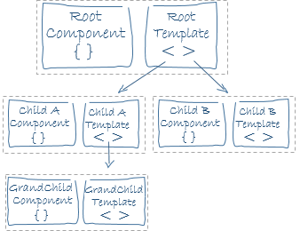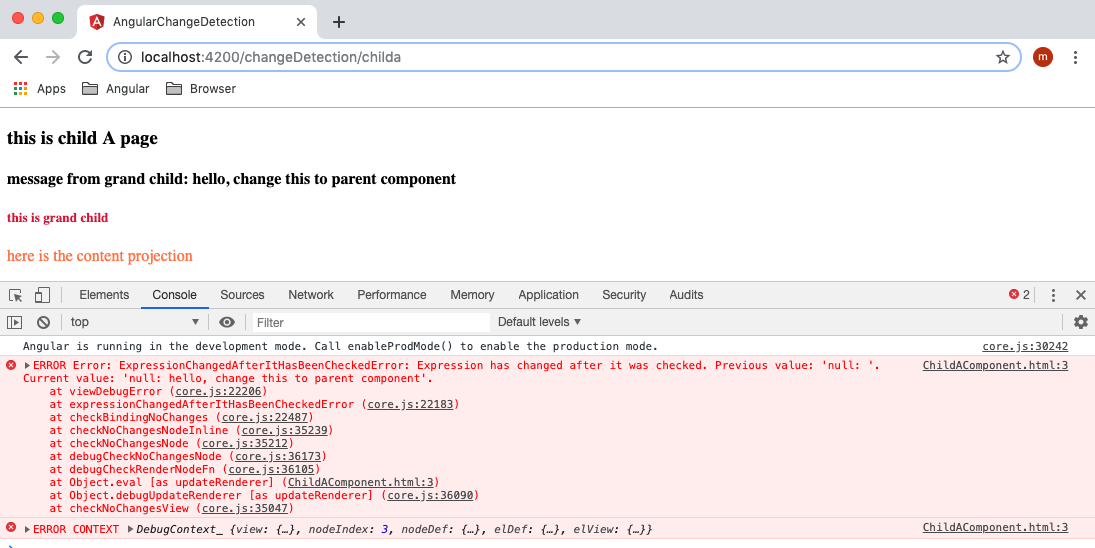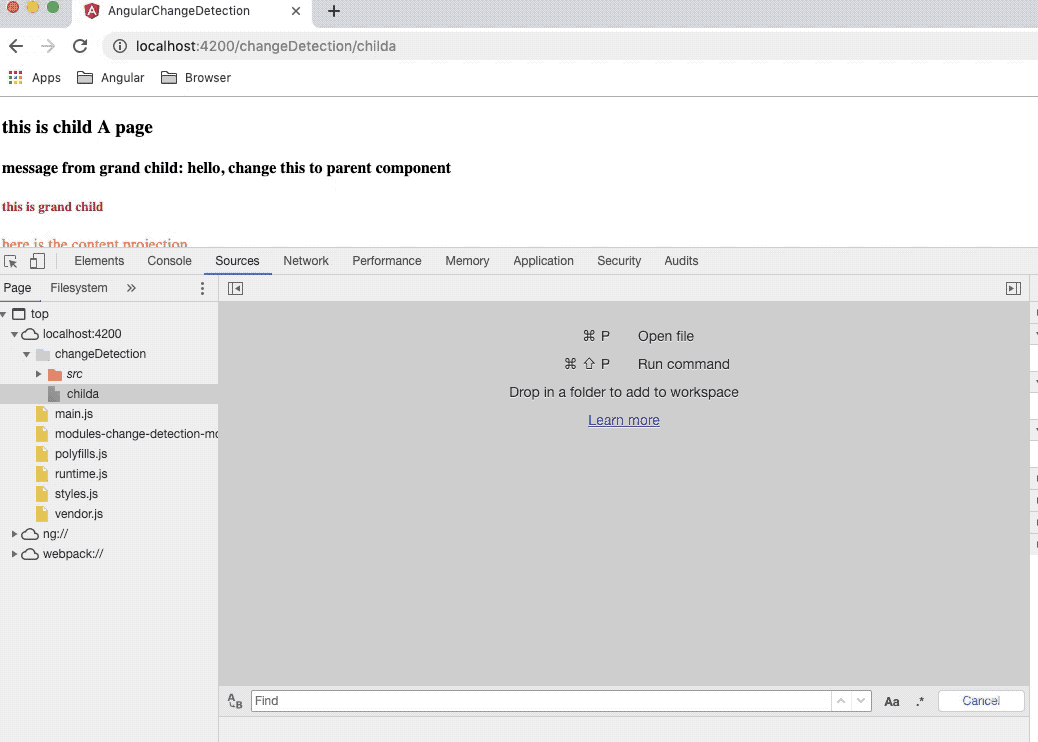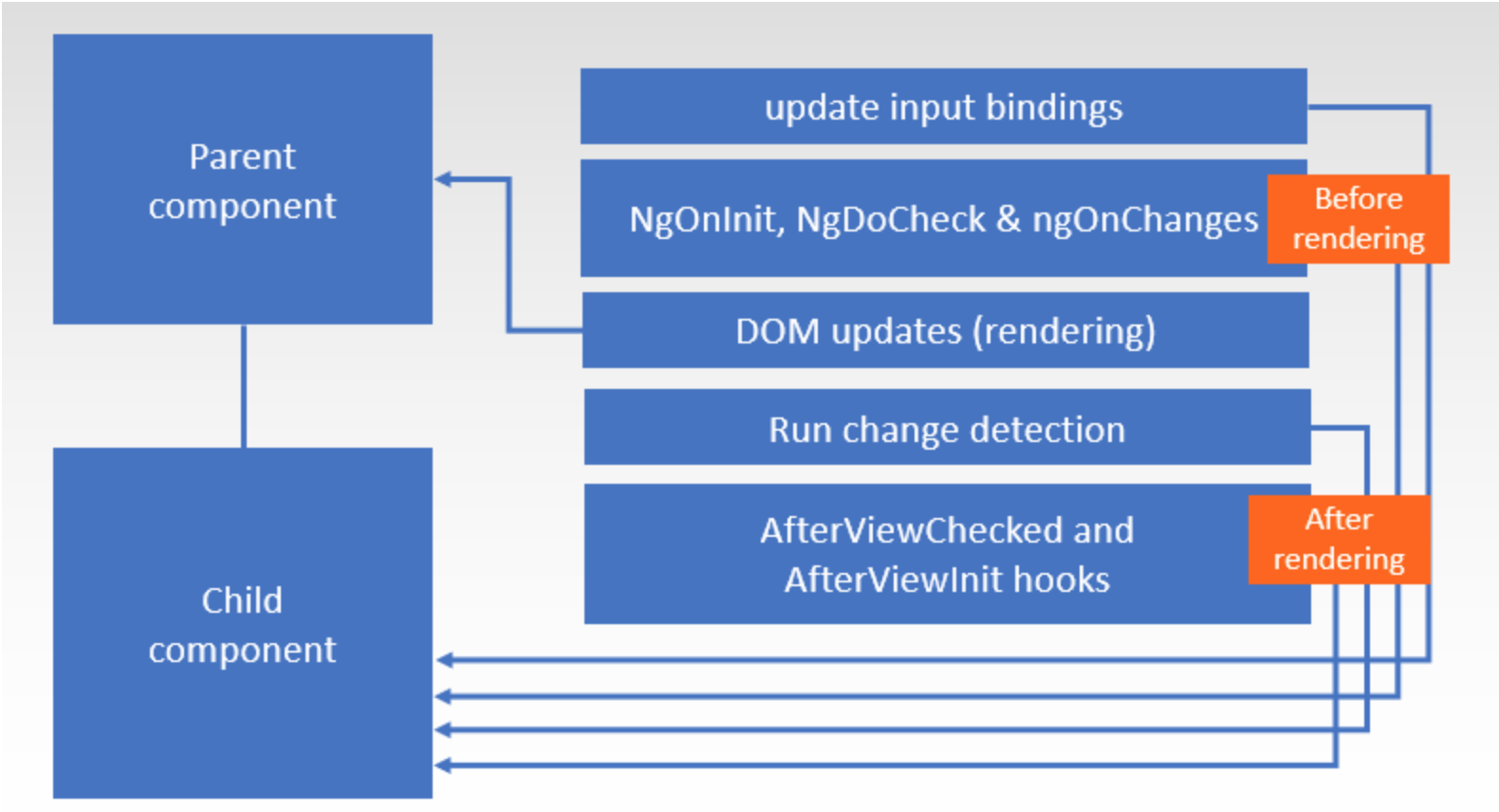在介绍 Angular 单向数据流之前我们先来看下 Angular 中 component 之间关系树状结构图:

比如在 child A component 从 http response 拿到最新 model 的值,并且需要把变化后的值渲染到页面,这个过程会触发 child A component 的变化检测(change detection)。
这个变化检测不仅仅会在 child A component 中执行,它会从 root component 开始沿着 component 关系树结构从上到下执行,直到最后一个 child component 完成变化检测达到稳定状态。也就是说在 GrandChild component 中也会触发执行变化检测,如果 GrandChild component 中还有它自己的 child component,会继续触发它的 child component 的变化检测。在这个从上到下的变化检测流中,一旦 child A component 中的变化检测已经完成了,任何在 GrandChild component 或者更低层级的 component 都不允许去改变 child A component 中的属性。
这个过程就是 Angular 的单向数据流。
但是在 GrandChild component 里,有些钩子函数通过@Output去改变 child A component 的数据值,是允许的,而有些又不允许。
现在我们来看看,如果在 GrandChild component 的钩子函数里通过@Output去改 child A component 的值,会发生什么?
定义一个 ChildAComponent,在这里会显示从 GrandChildComponent 发过来的 message,代码如下:
@Component({
template:`<h3 style="color: black">this is child A page</h3>
<h4 style="color: black">message from grand child: { { msgFromGrandChild } } </h4>
<app-grand-child (sendMsgToParent)="getMsgFromGrandChild($event)">
<span style="color: coral">here is the content projection</span>
</app-grand-child>`
})
export class ChildAComponent {
msgFromGrandChild: any = '';
getMsgFromGrandChild(value: any) {
this.msgFromGrandChild = value;
}
}
定义一个 GrandChildComponent,通过 @Output 向 ChildAComponent 发送 message,代码如下:
@Component({
selector: "app-grand-child",
template: `<h5 style="color: crimson">this is grand child</h5>
<ng-content></ng-content>`
})
export class GrandChildComponent implements OnInit {
@Output() sendMsgToParent: EventEmitter<any> = new EventEmitter<any>();
msg = "hello, change this to parent component"
ngOnInit() {
this.sendMsgToParent.emit(this.msg);
}
}
1. GrandChild 组件,在 ngOnInit 函数中改变了 ChildAComponent 的 msgFromGrandChild 属性的值
效果如下:message 能正常显示也没有 error:

把 ngOnInit 换成 ngDoCheck、ngAfterContentInit、ngAfterContentChecked、ngOnChanges,效果是一样的,在 ChildAComponent 中 message 都能正常显示也不会报错。
2. GrandChild 组件,在 ngAfterViewInit 中去改 childA 组件 msgFromGrandChild 属性的值
代码如下:
export class GrandChildComponent implements AfterViewInit {
@Output() sendMsgToParent: EventEmitter<any> = new EventEmitter<any>();
msg = "hello, change this to parent component"
ngAfterViewInit() {
this.sendMsgToParent.emit(this.msg);
}
}
这个时候会发现在 console 里会有ExpressionChangedAfterItHasBeenCheckedError,具体如下:

如果把 ngAfterViewInit 换成 ngAfterViewChecked,效果也是一样的,会有同样的错误。
出现这种错误的原因是: 在 Angular 中强制了单向数据流,当有变化的时候,变化检测机制是沿着 component 关系树结构从上到下执行,直到最后一个 child component 变化检测完成,这个完整的变化检测才算结束。在这个过程中,parent component 的变化检测完成以后,任何更低一层级去改上一层级的属性,都不允许。如果是在生产环境里,也就是启用了 enableProdMode() 会直接忽略这样的操作,页面也不会显示变化以后的值,也不会报错。但是在开发模式下,在每一次变换检测(change detection)以后,Angular 会从上到下再多跑一个变化检测,确保每次改动之后所有的状态是 stable 的,这个时候发现有低层级改动上一层级的值,就会出现上面那个错误。
那为什么在 ngAfterViewInit 和 ngAfterViewChecked 会报错,而且其他几个钩子函数里不报错呢?
我们来调试一下他的 core.js 源代码,具体调试方法如下:

把checkAndUpdateView方法简化一下:
function checkAndUpdateView(view, ...) {
...
// update input bindings on child views (components) & directives,
// call NgOnInit, NgDoCheck, ngOnChanges,ngAfterContentInit, ngAfterContentChecked hooks if needed
Services.updateDirectives(view, CheckType.CheckAndUpdate);
// DOM updates, perform rendering for the current view (component)
Services.updateRenderer(view, CheckType.CheckAndUpdate);
// run change detection on child views (components)
execComponentViewsAction(view, ViewAction.CheckAndUpdate);
// call AfterViewChecked and AfterViewInit hooks
callLifecycleHooksChildrenFirst(…, NodeFlags.AfterViewChecked…);
...
}
从上面的代码可以看出来,在 GrandChild component 中,AfterViewChecked和AfterViewInit是在它自己的变化检测(change detetion)之后再执行的,也就是它状态 stable 之后再执行的,这时候在去触发它上一层级属性的改动,被认为是违反 Angular 的单向数据流。
从上面的分析可以看到:Angular 在变化检测(change detection)过程中也会去触发生命周期钩子函数。比较有意思的是,有些钩子函数是在 DOM Rending/change detection 之前触发,有些是在之后触发。
最后来总结一下,在 Angular 整个页面渲染的过程:

-
更新 child component 的 input bindings,然后会触发 child component 中 OnInit、DoCheck、OnChanges 函数,如果页面有 ng-content,相应也会触发 ngAfterContentInit 和 ngAfterContentChecked。
-
Angular 会继续渲染当前 component 也就是 parent component 页面。
-
触发 child component 中的变化检测(change detection)。
-
触发 child component 中的 AfterViewInit 和 theAfterViewChecked。
在【Angular Change Detection:变化检测机制】这篇文章里介绍了变化检测机制。
本文中用到的示例代码在这里:angular-change-detection